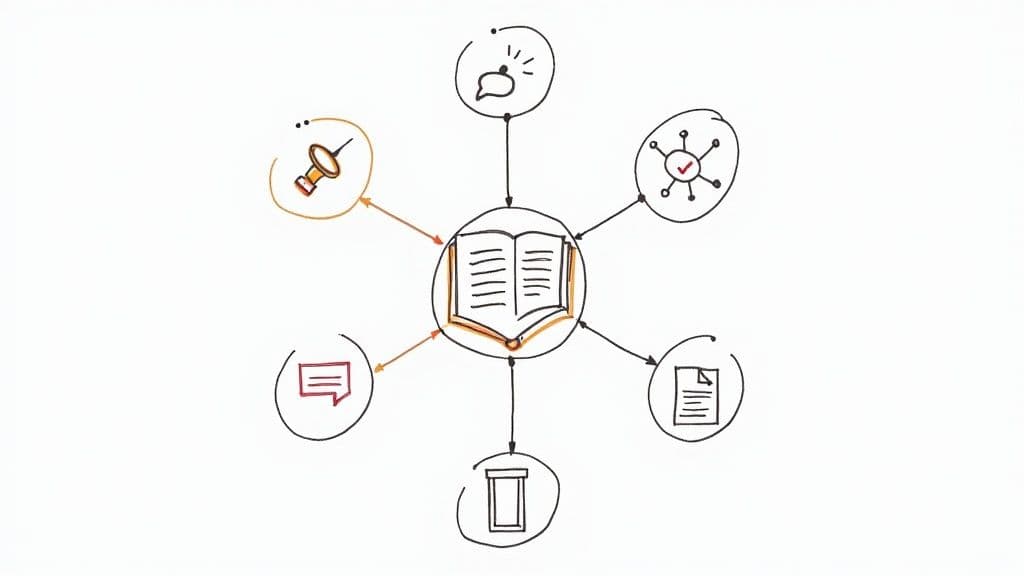7 Crisis Communication Best Practices for 2025
October 1, 2025

A crisis can materialize from anywhere: a product flaw, a data breach, or a single viral tweet. How an organization responds in the first few hours determines whether the event becomes a manageable issue or a catastrophic failure. The ability to navigate these high-stakes moments effectively is not a matter of luck; it’s the result of preparation, strategy, and a deep understanding of public perception. Strong crisis communication isn't just about mitigating damage; it’s an opportunity to showcase integrity, build stakeholder trust, and reinforce core brand values under pressure. Without a clear plan, even the most successful companies risk significant, long-lasting reputational harm.
This guide provides a clear, actionable framework for mastering these critical situations. We will break down seven essential crisis communication best practices that every leader, from startup founders to seasoned PR professionals, must know. You will learn how to respond with speed and transparency, map stakeholder needs, take accountability, and deploy a multi-channel strategy. We will also cover how to lead with empathy and establish a consistent leadership voice. Each point is designed to be a practical, no-nonsense tool you can implement immediately to protect your organization and emerge from any challenge with your reputation intact.
1. Speed and Transparency in Response
In a crisis, the digital landscape moves at lightning speed. Your first move is arguably your most critical, which is why speed and transparency are paramount among crisis communication best practices. This approach involves responding immediately with honest, accurate information as it becomes available. The goal is to control the narrative by being the first and most reliable source of truth, thereby preventing misinformation from taking root.
This strategy isn't about having all the answers instantly. It's about acknowledging the situation, showing you're actively addressing it, and committing to open communication. A delayed response creates an information vacuum that will be filled by speculation, rumors, and competitors, causing irreparable damage to your brand’s reputation.

Historical Precedent: The Tylenol Case
The gold standard for this approach remains Johnson & Johnson's response to the 1982 Tylenol poisoning crisis. Instead of downplaying the issue, CEO James Burke acted swiftly and decisively. The company immediately pulled all Tylenol products from shelves nationwide, a move that cost them millions but saved their reputation. They were transparent with the public, prioritized customer safety above profits, and ultimately emerged stronger.
Key Insight: Prioritizing public safety and being transparent, even at a significant short-term cost, builds long-term trust and brand loyalty.
Actionable Implementation Steps
To effectively implement this strategy, your team must be prepared to act before a crisis hits.
- Establish a Rapid Response Team: Designate a core group with clear roles and decision-making authority. This team should include members from PR, legal, and executive leadership who can convene and act within minutes.
- Utilize the 'Golden Hour' Principle: Aim to issue an initial public statement within 60 minutes of a crisis breaking. This first communication should acknowledge the situation, express empathy for those affected, and state that you are gathering facts.
- Develop Pre-Approved Templates: Create messaging templates for various potential scenarios (e.g., data breach, product recall, service outage). These templates allow your team to respond quickly with approved, on-brand language while filling in the specific details of the current event.
- Prioritize Honesty: Never speculate or provide unconfirmed information. It is better to say, "We don't have that information right now, but we are working to find out and will update you by [specific time]," than to make a statement you later have to retract. This builds credibility and manages expectations.
2. Stakeholder Mapping and Targeted Messaging
A crisis doesn't impact everyone in the same way. One of the most critical crisis communication best practices is to move beyond a one-size-fits-all message and adopt a targeted approach. Stakeholder mapping involves identifying every group affected by the crisis, from customers and employees to investors and regulators, and tailoring communication specifically to their distinct needs and concerns. This ensures that each audience receives relevant information that directly addresses their questions, fostering trust and mitigating panic.
This strategic approach recognizes that an investor's primary concern is financial impact, while an employee's is job security and a customer's is product safety. Generic statements often fail to resonate because they don't speak to these specific anxieties. By segmenting your audience, you can deliver empathetic and effective messages through the channels each group trusts most, demonstrating a deep understanding of your operational ecosystem.

Historical Precedent: Facebook's Cambridge Analytica Scandal
During the 2018 Cambridge Analytica data privacy scandal, Facebook faced a multi-front crisis. The company had to communicate with vastly different groups simultaneously. They issued public apologies and technical explanations for users, provided advertisers with assurances about data security and platform integrity, and engaged in direct, detailed dialogue with government regulators in the U.S. and Europe. This differentiated messaging acknowledged that the concerns of a casual user were different from those of a multinational advertiser or a congressional committee, allowing for more precise damage control.
Key Insight: Acknowledging the unique concerns of each stakeholder group and tailoring your message accordingly demonstrates competence and empathy, preventing alienation and building targeted goodwill.
Actionable Implementation Steps
Effective stakeholder communication begins long before a crisis strikes. Proactive planning is essential.
- Create Stakeholder Maps in Advance: Identify and map out all potential stakeholders. Group them by their level of interest and influence, from primary (employees, customers) to secondary (media, community groups).
- Develop Stakeholder Personas: For each key group, create a detailed persona. What are their primary concerns? What information will they need? What is their preferred communication channel (e.g., email, social media, press conference, internal town hall)?
- Assign Relationship Managers: Designate specific team members to be the primary point of contact for key stakeholder groups. This ensures consistent communication and helps build relationships before a crisis hits. For an in-depth guide on audience-centric communication, explore these public relations strategy examples.
- Prepare Differentiated Message Templates: Draft core messaging points for different crisis scenarios, then adapt them for each key stakeholder. An investor message will focus on financial stability, while a customer message will prioritize safety and service continuity.
3. Taking Responsibility and Showing Accountability
One of the most difficult, yet crucial, crisis communication best practices is to take ownership of the situation. This means openly acknowledging any mistakes, accepting responsibility for the problem, and demonstrating concrete steps to address the issues and prevent them from happening again. This approach shifts the focus from deflecting blame to rebuilding trust through genuine accountability.
Attempting to minimize the issue, shift blame, or use evasive language only deepens public distrust and prolongs the crisis. A sincere apology and a clear action plan show respect for those affected and signal that your organization is committed to making things right. This candor can disarm critics and lay the foundation for reputational recovery.

Historical Precedent: Starbucks' Swift Action
A powerful example of this principle is Starbucks' response to the 2018 arrest of two Black men in a Philadelphia store. Instead of making excuses, then-CEO Kevin Johnson flew to Philadelphia to meet with the men, issued a public apology, and took full responsibility. The company then closed over 8,000 U.S. stores for a day to conduct racial-bias training for its employees. This decisive, visible action demonstrated a profound commitment to addressing the root cause of the problem.
Key Insight: Actions speak louder than words. Pairing a sincere apology with tangible, meaningful action is the most effective way to demonstrate accountability and begin rebuilding trust.
Actionable Implementation Steps
To integrate accountability into your crisis response, focus on sincerity and follow-through.
- Apologize for the Impact: Even if the intent wasn't malicious, acknowledge the negative impact on stakeholders. A statement like, "We are deeply sorry for the frustration and concern this has caused," is more effective than a defensive explanation.
- Have Leadership Be the Face of the Response: Accountability is most believable when it comes from the top. The CEO or other senior leaders should personally deliver key messages to show the organization is taking the issue seriously at the highest levels.
- Avoid Insincere 'Non-Apologies': Steer clear of legal jargon and phrases like "we regret if anyone was offended." These statements sound evasive and undermine the sincerity of your message. A straightforward apology is always better.
- Outline Concrete Corrective Actions: Follow your apology with a clear plan. Detail the specific steps you are taking to fix the problem and prevent recurrence, including timelines for these measures. This shows you are not just sorry, but also committed to change.
4. Multi-Channel Communication Strategy
In a fragmented media environment, relying on a single channel to disseminate critical information is a recipe for failure. A multi-channel communication strategy is one of the most vital crisis communication best practices, ensuring your message reaches various stakeholders where they are most active. This approach involves a coordinated effort across social media, email, your website’s press center, traditional media, and internal platforms to maintain a consistent narrative.
The core principle is to use different channels to reinforce the same core message, tailored to each platform's format and audience. This prevents confusion, counters misinformation more effectively, and demonstrates a comprehensive and organized response. Failing to communicate across multiple channels creates information silos, leaving key audiences like employees, customers, or investors in the dark.

Historical Precedent: Chipotle's Food Safety Crisis
Chipotle’s response to its E. coli outbreak in 2015-2016 provides a clear example of a multi-channel strategy in action. The company used a combination of press releases for major announcements, full-page newspaper ads to apologize and outline new safety protocols, and a heavy social media presence to engage directly with concerned customers. They also closed all stores for a company-wide meeting on food safety, communicating this action broadly to signal the seriousness of their commitment. This integrated approach, though reactive, was essential in rebuilding trust across their diverse customer base. You can explore how brands coordinate messaging across platforms by learning more about integrated marketing communications.
Key Insight: A unified message delivered across multiple, carefully selected channels amplifies its reach and credibility, ensuring all stakeholder groups receive timely and consistent information.
Actionable Implementation Steps
To execute a multi-channel strategy effectively, you must lay the groundwork before a crisis emerges.
- Establish a Central Content Hub: Create a single source of truth, such as a dedicated page on your website, where all official information, updates, and statements are posted. All other channels should direct traffic back to this hub.
- Create Platform-Specific Content: While the core message must be consistent, its delivery should be adapted for each channel. A formal press release for media, a concise and empathetic update for Twitter, a detailed email for customers, and an internal memo for employees will be more effective than a one-size-fits-all post.
- Designate Channel Managers: Assign specific individuals to manage and monitor each communication channel. These managers should have clear guidelines on what they can post and well-defined procedures for escalating issues or questions to the central crisis team.
- Utilize Social Listening Tools: Implement social media monitoring tools to track the conversation across all platforms in real-time. This allows you to identify emerging rumors, gauge public sentiment, and respond directly to stakeholder concerns before they escalate.
5. Empathy-Driven Messaging
In any crisis, stakeholders are not just processing facts; they are experiencing emotions like fear, anger, and uncertainty. Empathy-driven messaging is a core crisis communication best practice that prioritizes human connection over corporate-speak. It involves communicating in a way that acknowledges and addresses the emotional and practical concerns of those affected, demonstrating genuine care for their wellbeing.
This approach moves beyond simply relaying information and focuses on building trust by showing that your organization understands the human impact of the situation. By leading with empathy, you validate stakeholder feelings, reduce anxiety, and create a foundation for a more constructive dialogue, which is crucial for preserving brand loyalty and reputation.
Historical Precedent: Airbnb's Disaster Response
Airbnb’s response to natural disasters showcases empathy in action. When crises like hurricanes or wildfires displace people, the company activates its Open Homes program, which connects affected residents and relief workers with hosts offering free temporary housing. Their communication is not just about the program; it’s filled with messages of support for the community and focuses on the shared value of helping one another. This empathetic approach reinforces their brand mission and builds immense goodwill.
Key Insight: Communicating with genuine empathy and providing tangible support transforms a corporate response into a human one, strengthening community ties and brand affinity.
Actionable Implementation Steps
To effectively integrate empathy into your crisis response, your team must shift its mindset from damage control to genuine care.
- Practice Active Listening on Social Media: Before issuing a statement, monitor social media and customer service channels to understand what your audience is feeling and saying. Use this insight to shape a message that directly addresses their specific concerns and emotions.
- Train Spokespeople in Emotional Intelligence: Your designated spokespeople must be able to convey compassion and sincerity. Invest in training that focuses on empathetic communication, active listening, and the ability to connect with an audience on an emotional level.
- Avoid Corporate Jargon: Use simple, clear, and human language. Phrases like "optimizing synergies" or "leveraging assets" create distance. Instead, use direct and heartfelt language such as, "We are deeply sorry for the hardship this has caused, and we are here to help."
- Focus on Actions, Not Just Words: Empathy without action can feel hollow. Back up your empathetic words with concrete steps you are taking to support those affected. Outline the support systems, resources, or solutions you are providing to help them through the crisis.
6. Proactive Crisis Prevention and Preparedness
The most effective crisis communication best practices often involve actions taken long before a crisis ever materializes. Proactive crisis prevention and preparedness is the strategic discipline of identifying potential risks, developing robust response protocols, and building a resilient communication infrastructure in advance. It shifts the focus from reactive damage control to proactive risk mitigation and readiness.
This forward-thinking approach ensures that when a crisis strikes, your organization isn't scrambling to figure out what to do. Instead, you are activating a well-rehearsed plan. By anticipating potential vulnerabilities, from supply chain disruptions to cybersecurity threats, you can build a framework that minimizes impact and accelerates recovery, preserving stakeholder trust through demonstrable competence.
Historical Precedent: Disney's Operational Readiness
Disney’s theme parks are a masterclass in proactive preparedness. Facing risks from weather events to technical failures, the company has developed comprehensive protocols for nearly every conceivable scenario. Their well-trained staff, clear communication chains, and pre-planned operational responses ensure that guest safety and experience are maintained even during unforeseen events, making their crisis management nearly invisible to the public.
Key Insight: The best crisis management is often unseen. Investing in prevention and preparedness means you can manage and resolve many issues before they ever escalate into a public-facing crisis.
Actionable Implementation Steps
To build a truly proactive crisis framework, your organization must integrate preparedness into its core operations.
- Conduct Regular Risk Assessments: Systematically identify potential threats to your organization, categorizing them by likelihood and potential impact. This includes operational, reputational, financial, and technological risks.
- Run Crisis Simulation Exercises: Don't just write a plan; test it. Conduct regular drills and simulations with your leadership team to stress-test your protocols, identify weaknesses, and build "muscle memory" for a real crisis.
- Establish Clear Protocols and Hierarchies: Define who is on the crisis team, what their specific roles are, and who has the authority to make critical decisions. This clarity prevents confusion and delays when time is of the essence.
- Develop Pre-Approved Messaging: Create a "crisis playbook" with pre-approved message templates and talking points for various scenarios. Having these ready allows for a swift and consistent initial response. For more guidance on crafting effective public statements, explore these press release best practices.
7. Consistent Leadership Presence and Voice
During a crisis, stakeholders look for a steady hand at the helm. A consistent leadership presence provides that reassurance, demonstrating that the organization is in control and taking the situation seriously. This crisis communication best practice involves designating a primary spokesperson who can serve as the authoritative and empathetic face of the company, ensuring a steady, reliable voice across all channels.
This strategy humanizes the organization and builds trust. When a leader is visible, accountable, and communicates with a consistent tone, it cuts through the noise and confusion. It shows that leadership is not hiding but is actively engaged in finding a solution, which is critical for maintaining stakeholder confidence and managing the narrative effectively.
Historical Precedent: Apple's Privacy Stance
When Apple faced significant public and governmental pressure regarding user privacy and device encryption, CEO Tim Cook became the consistent, visible face of the company's response. He personally authored public letters and gave high-profile interviews, clearly and consistently articulating Apple's unwavering commitment to user privacy as a core value.
Instead of delegating to a PR team, Cook’s direct involvement showed the gravity with which Apple treated the issue. This consistent leadership voice reinforced the company's brand principles and provided a clear, authoritative stance that resonated with customers and stakeholders, solidifying trust in the brand's integrity.
Key Insight: A visible and consistent leader serves as an anchor in a storm, providing the stability and accountability that stakeholders crave during uncertainty.
Actionable Implementation Steps
To ensure a strong leadership voice, you need to prepare key individuals long before a crisis strikes.
- Select Spokespeople Strategically: Choose your spokesperson based on their credibility, empathy, and communication skills, not just their job title. The right person can connect with the audience on a human level.
- Provide Advanced Media Training: Invest in comprehensive media and crisis communication coaching for all designated spokespeople. This training should include simulated press conferences and difficult Q&A sessions to build confidence and refine messaging.
- Establish a Clear Chain of Command: Designate primary and backup spokespeople to ensure availability. Everyone on the crisis team should know who is authorized to speak publicly to avoid mixed messages.
- Schedule Regular, Proactive Updates: Maintain a regular cadence of communication, even if there is no new information to share. A brief update stating, "We are still investigating and will provide more details at [time/date]," is better than silence, as it shows continued engagement.
Crisis Communication Best Practices Comparison
| Strategy | Implementation Complexity 🔄 | Resource Requirements ⚡ | Expected Outcomes 📊 | Ideal Use Cases 💡 | Key Advantages ⭐ |
|---|---|---|---|---|---|
| Speed and Transparency in Response | Moderate to High: rapid fact-checking needed | High: rapid response team required | Builds trust quickly; prevents misinformation; shows control | Immediate crisis response; preventing rumor spread | Trust building; accountability; reduces speculation |
| Stakeholder Mapping and Targeted Messaging | High: extensive mapping and coordination | High: customized messaging and monitoring | Increased message relevance; stronger relationships | Complex crises involving diverse stakeholder groups | Message relevance; efficient resource allocation |
| Taking Responsibility and Showing Accountability | Moderate: leadership involvement crucial | Moderate to High: remediation plans needed | Rebuilds trust; demonstrates ethics; often reduces penalties | Crises involving organizational fault or mistakes | Ethical leadership; faster trust recovery |
| Multi-Channel Communication Strategy | High: coordination across many platforms | High: content creation and management | Maximizes reach; real-time engagement; redundancy | Broad audience crises requiring diverse channel use | Wide reach; stakeholder accommodation; preparedness |
| Empathy-Driven Messaging | Moderate: requires emotional intelligence | Moderate: training and message crafting | Builds emotional trust; reduces negative sentiment | Crises impacting emotions and stakeholder wellbeing | Emotional connection; authenticity |
| Proactive Crisis Prevention and Preparedness | High: ongoing risk assessments and training | High: upfront investment and maintenance | Faster future responses; reduces panic; prevents escalation | Organizations focusing on risk management and long-term readiness | Preparedness; organizational maturity |
| Consistent Leadership Presence and Voice | Moderate: spokesperson selection and training | Moderate: leadership time commitment | Builds confidence; message consistency; accountability | Any crisis needing steady communication and leadership visibility | Stability; clear communication; leadership commitment |
Building Resilience: Your Next Steps in Crisis Communication
Navigating the turbulent waters of a crisis is one of the most significant challenges any organization will face. As we have explored, a successful outcome is not a matter of luck; it is the direct result of deliberate, strategic preparation and execution. The best practices detailed in this article provide a comprehensive roadmap for transforming potential disasters into opportunities to reinforce stakeholder trust and brand integrity.
From the immediate necessity of Speed and Transparency to the long-term value of Proactive Crisis Prevention, each principle works in concert to create a robust communication framework. Remember, your response begins long before a crisis hits. It is cultivated in the consistent efforts you make to understand your stakeholders, establish clear lines of communication, and foster a culture of accountability.
Recapping Your Crisis Communication Toolkit
The strategies we’ve covered are not isolated tactics but interconnected pillars of a resilient organization. Let’s briefly revisit the core takeaways:
- Act Fast and Be Honest: Your initial response sets the tone. Prioritize speed and transparency to control the narrative and build immediate trust.
- Know Your Audience: Effective communication isn't one-size-fits-all. Use stakeholder mapping to tailor your messages for maximum impact and resonance.
- Own Your Actions: Taking responsibility is non-negotiable. A sincere apology and a clear plan for resolution can defuse anger and demonstrate integrity.
- Communicate Everywhere: Your stakeholders are on multiple platforms. A multi-channel strategy ensures your message is consistent, accessible, and reaches everyone who needs to hear it.
- Lead with Empathy: A crisis affects real people. Acknowledging their feelings and concerns is crucial for maintaining relationships and rebuilding confidence.
- Prepare for What's Next: The best crisis response is preventing one from happening. Proactive planning and simulations turn your team from reactive firefighters into strategic guardians of your reputation.
- Be a Visible Leader: During uncertainty, people look to leadership for stability. A calm, consistent, and visible presence provides reassurance and direction.
Turning Theory into Action
Mastering these crisis communication best practices is an ongoing journey, not a final destination. The true value lies in embedding these principles into your company’s DNA. This means moving beyond theoretical knowledge and taking concrete, actionable steps today.
Start by conducting a thorough audit of your current crisis plan. Is it up-to-date? Does it account for modern challenges like social media firestorms? Run a crisis simulation with your leadership team to identify gaps in your response protocol and build muscle memory for when a real event occurs. Empower your team with the training and tools they need to execute their roles confidently under pressure.
Ultimately, a strong crisis communication strategy is more than a defensive measure; it is a powerful tool for brand building. It demonstrates your organization's character, commitment to its values, and respect for its stakeholders. The work you invest now will pay invaluable dividends, ensuring your organization not only survives the next storm but emerges from it stronger, more trusted, and more resilient than before.
Ready to take control of your narrative before, during, and after a crisis? PressBeat uses AI to connect you with the right journalists, helping you manage media relationships and distribute your message with precision when it matters most. Build your media outreach foundation today by visiting PressBeat.